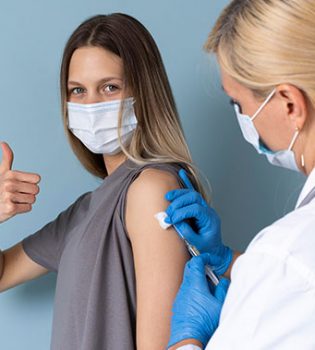If we look at the history, preinvasive lesions were first described by Cullen in 1900 with reference to non-invasive lesions in the uterus. Subsequently, Schaueristein (1908), Pronai (1909), and Rubin (1910) suggested that the superficial metaplastic epithelium is the early stage of squamous cell carcinoma. In 1927 Schiller presented findings supporting the concept of preinvasive neoplasia and Broders used the term carcinoma in situ (CIS) for the first time in 1932. In the 1940s, Papanicolau brought up exfoliative cytology and suggested its use in the screening of uterine and cervical cancers.In the 1950s, the American Cancer Society supported the use of cervical cytology for screening purposes (1).
The term preinvasive cervical disease was used in 1947 to describe changes that have the appearance of invasive cancer but are limited to the epithelium. In 1956, Reagan et al. named the abnormalities showing the histological and cytological differences between CIS and normal epithelium as dysplasia; divided into 3 groups as mild, moderate and severe. At the 1st International Congress of Exfoliative Cytology in 1961, it was decided to use the term CIS for lesions formed by undifferentiated neoplastic cells of the entire thickness of the epithelium. Thinking that dysplasia and CIS are different steps of a continuous event, Richart defined the term cervical intraepithelial neoplasia (CIN I, II, III) in 1967. Subsequent studies showed that these lesions, if left untreated, may lead to cervical cancer (1).
With the introduction of the 2001 Bethesda system for cytological abnormalities, the terms LSIL (Low grade squamous intraepithelial lesion) and HSIL (High grade squamous intraepithelial lesion) were introduced into our clinical terminology to describe lesions with the potential to transform into cervical cancer. In histological classification, CIN1 includes low-grade lesions and CIN2,3 includes high-grade lesions. It should always be kept in mind that cytological LSIL is not equal to histological CIN1 and cytological HSIL is not equal to histological CIN 2,3 (1).
In this compilation, the definition of cervical preinvasive lesions, their incidence in the world and in our country, and the management algorithm recommended by the American cervical pathology and colposcopy society will be summarized.

Definition of Cervical Intraepithelial Neoplasia
Definition, Etiology, Histology and Classification of CIN:
Abnormal cervical lesions; It is called Cervical Intraepithelial Neoplasia I (CIN I) if it is limited in the lower 1/3 of the epithelium, CIN II if involved in the lower 2/3, CIN III if almost all of the epithelium is involved, and Carcinoma In Situ (CIS) if it includes the entire epithelium. The basal membrane is intact in all lesions. However, there is potential for invasion in CINs at every stage.
Invasive cervical cancers usually follow a long stage of preinvasive disease. Microscopically, it is characterized by a spectrum of precursor lesions that progress from cellular atypia to varying degrees of cervical intraepithelial neoplasia (CIN) before progressing to invasive carcinomas. Epidemiological studies have identified a number of risk factors involved in the development of CIN and cervical cancer, but today the most important one is HPV (11).
Invasive cervical cancer is considered to be a preventable cancer because of its long preinvasive period of 10-15 years, availability of cytological screening methods, and effective treatment of preinvasive lesions. As a matter of fact, among all cancers, cervical cancer is the most successful in preventive approaches. Despite this, it was determined that there were 12,200 new invasive cervical cancer cases and 4100 related deaths in 2003 in the USA. Cervical cancer is the 3rd most common gynecological cancer after endometrial and ovarian cancer, and the 3rd most common cause of death due to gynecological cancer after ovarian and endometrial cancer (2). In developing countries, however, the most common gynecological cancer is cervical cancer, and in these countries, most of the patients are at an advanced stage at the time of diagnosis, which causes the disease to be mortal (Figure 1) (3).
The average age of incidence of cervical cancer is approximately 53 (4). The disease shows a bimodal age distribution, with the highest incidences between 35-39 and 60-64 years of age. (1).
There are several risk factors for the development of cervical cancer, these are (4):
-First coitus at an early age (before 16 years old)
-Multiple sexual partners
-Sexually transmitted diseases, especially Human Papilloma Virus (HPV) infection
-Smoking (active or passive)
-Race
-High parity
-Low socioeconomic level
The development of cervical cancer takes a long time, in adolescence, the lesions are usually low-grade, and most of these lesions regress spontaneously, while a few turn into cervical intraepithelial neoplasms (CINs). The median ages of CIN 1,2 and 3 are 25,29 and 34 years, respectively (5). At least 2/3 of CIN 1, half of CIN 2 and 1/3 of CIN 3 regress, in the end a small proportion of lesions eventually progressing to invasive cancer (3).

The initiating factor in cervical dysplasia and carcinogenesis is Human Papilloma Virus (HPV) infection. Genital HPV infection is the most common sexually transmitted disease worldwide today (6). It is estimated that the lifetime risk of HPV infection in sexually active individuals is 80-85% (7). HPV-DNA is detected in more than 99% of cervical tumors (8).
The cervix is particularly vulnerable to this infection during adolescence, when squamous metaplasia is most active. As a matter of fact, the age group with the highest prevalence of HPV is 20-24, then 15-19. Most women, especially the young, respond effectively and clear the infection within 1-2 years or reduce the viral load to undetectable levels (9). Thus, the prevalence decreases rapidly after the age of 30, the most important factor in this is the regression of the transformation zone, which is prone to infection, with age. However, this infection may progress to premalignant and preinvasive lesions in the epithelium in smokers and those with immunodeficiency (10). Accordingly, cervical cancer occurs in susceptible individuals in response to sexually transmitted infection of high-risk HPV types.
Since HPV infection is very common in young people and the possibility of spontaneous regression with age is high, it has been found that the specificity of detecting high-grade lesions will increase if HPV testing is applied to women over 30 years old (11).
More than 100 types of HPV have been identified. High-risk types are associated with intraepithelial neoplasms and are more likely to progress to cancer in these types. Among these types, the most common and most carcinogenic are types 16 and 18. Low-risk types are mostly responsible for genital condylomas, and types 6 and 11 are the most common ones (11). The mean time between the first HPV infection and invasive cancer is 15 years (Figure 3) (12).
There are also effective treatment modalities that will prevent the development of invasive disease in patients diagnosed at the preinvasive stage by cytological screening (18). Sampling or interpretation errors are responsible for 25-30% of new cervical cancer diagnoses, and not performing or suboptimal screening for 50-60% (19). Half of the patients diagnosed with cervical cancer have never had a smear test, and 10% have not been screened in the last 5 years (Chart 1,2) (20).
Despite this success of Pap smear, a meta-analysis found that its sensitivity was 51% and its specificity was 98% in terms of detecting cervical cancer (20). Therefore, the most important limitation of the Pap test is the high false-negative rates, and this rate has been reported as 5-10%. According to these data, 1 out of every 10-20 positive cases is missed by routine conventional Pap smear screening. It is estimated that 2/3 of the false-negative results are due to sampling errors and 1/3 of them are due to interpretation errors (22). To compensate for this, it is recommended to repeat the test at certain intervals, so that the sensitivity is increased and medicolegal problems caused by false-negative results are prevented.
Management in Patients with Abnormal Cervical Cytology Results
Approximately 50 million Pap tests are performed annually in the USA, and approximately 3.5 million (7%) of these have a cytological abnormality that requires further evaluation or follow-up (37, 38). In September 2001, the American Society for Colposcopy and Cervical Pathology (ASCCP) held a consensus conference on the appropriate management of patients with cytological abnormalities. In that conference, the 2001 Bethesda System was used for cytological classification. Then this consensus guideline was revised again in 2006. According to this consensus meeting, appropriate management should be as described below in patients with cytological abnormalities (21)
What is colposcopy?
Colposcopy is a magnifying glass used for further examination of lesions that may be a precursor to cervical cancer in patients with abnormal cytology results. Colposcopy is the examination of the cervix with the help of a microscope or a special magnifying glass like binoculars. This instrument, called colposcope, allows the cervix, which is observed with the naked eye during normal gynecological examination, to be observed in a larger, clearer and more detailed manner. During the procedure, some dyes and substances are applied to the cervix to make the suspicious areas more prominent and to detect these areas that require biopsy.
Who gets colposcopy?
Conditions that require colposcopy and biopsy are:
-Women with a change in the cells of the cervix (dysplasia) forming the cervix as a result of PAP smear with the potential to develop into severe or moderate cancer. (Smear result ASCUS, , ASC-H,LSIL,HSIL, CIN II-III )
-Abnormal appearance of the cervix on examination
– Cytology histology mismatch
– bleeding after intercourse
Atypical squamous cells (ASC):
Atypical squamous cells are detected in 4.4% of all smears. These cells are also divided into 2 groups as ASC-US (ASC of undetermined significance) and ASC-H (ASC-cannot exclude high grade lesion) according to the Bethesda evaluation system. There are many factors that should be considered in the management of the patient to whom ASC is reported as a result of the smear. The rate of CIN 2.3 with biopsy confirmation in patients with such a cytology result is 5-17%. The rate of CIN 2,3 is 24-94% in patients diagnosed with ASC-H. It should be noted that a patient reported ASC-H is equivalent to HSIL. In the presence of atypical squamous cells, the risk of invasive cancer is 0.1-0.2%. Routine use of diagnostic excisional procedures is not recommended in such patients unless there is biopsy-confirmed CIN.
Data from the ALTS study and other studies revealed that 2 repeat smears at 6-month intervals, HPV testing, and one-time colposcopy are all safe and effective methods for the management of patients with ASC-US reported. For this reason, it was stated in the 2001 consensus recommendations that these 3 approaches are methods that can be used in the management of ASC-US.
“Reflex Test” is a name given to the study of HPV on original liquid-based cytology or a separate sample. This approach eliminates the need for women with abnormal cytology to come back for HPV testing and avoids unnecessary colposcopy.
Additional follow-up may be required as a single colposcopy examination may miss a significant cervical lesion. The ALTS study suggests different post-colposcopy follow-up schemes and found that the HPV test performed at 12 months after the initial colposcopy was equivalent to two repeat smears performed 6 months apart. Combining cytology and HPV testing did not increase sensitivity and decrease specificity.
Special Patient Populations
HPV-DNA positivity in women with ASC-US varies with the age of the woman. HPV DNA positivity in young women is higher than in older ones. Therefore, using the HPV DNA test in the adolescent population causes more patients to be referred to colposcopy, despite the low risk for cancer. ASC-US is less common in postmenopausal women than in premenopausal women, and the rate of finding a significant pathology in this age group is lower. HPV testing is more effective in older women with ASC-US than in younger women because it causes fewer women to go for colposcopy.
ASC-US is a common condition in women with HIV infection. It has been reported in previous studies that HPV-DNA positivity is high in this patient population. For this reason, it is recommended that all immunosuppressed women undergo colposcopy. More recent studies have reported lower rates of HPV positivity and CIN 2.3 compared to previous studies and therefore recommend that immunosuppressed women be managed as women in the general population. When ASC-US is detected in pregnant women, the risk of cancer is very low, so antepartum colposcopic evaluation was not included in the management.
Management of Women with ASC-US detection
General Approach
Repeat cytology at regular intervals, HPV DNA testing, or direct colposcopy are acceptable methods of managing women over 20 years of age with ASC-US. “Reflex HPV” testing may be the preferred method when liquid-based cytology is used.
Women with HPV-DNA negative ASC-US can be evaluated with repeat cytology at 12 months. HPV-DNA positive women are managed in the same way as LSIL and referred for colposcopy. Endocervical sampling is preferred in women without a visible lesion or if colposcopy is inadequate. Endocervical sampling is an acceptable approach in women with adequate colposcopy and lesion detection in the transformation zone. HPV positive but CIN negative women after colposcopy can be evaluated with HPV DNA testing at 12 months or repeat cytology at 6 and 12 months. It is recommended that HPV DNA testing should not be performed at intervals shorter than 12 months.
If repeat cytology is to be used in the management of ASC-US, it is recommended to continue cytology repeats at 6-month intervals until at least 2 consecutive tests are negative. If a lesion is detected on ASC-US or above in repeat cytology, colposcopy is recommended. If 2 cytology are negative, the patient is taken to the normal follow-up program.
If colposcopy will be used in the management of ASC-US, repeat cytology is recommended in the 12th month in the patient without CIN. The patient with CIN is followed up according to the appropriate ASCCP recommendations.
Routine diagnostic excisional intervention is not an accepted approach in the initial management of ASC-US (Figure 3).
ASC-US Management in Special Populations
Adolescent Women
A repeat cytology is recommended at 12 months in women with adolescent ASC-US.Only those with HSIL or higher lesions at the 12th month are referred for colposcopy. After 24 months of follow-up, women with lesions detected at or above ASC-US are referred for colposcopy (Figure 4).
Immunosuppressed Women
Women infected with HIV or immunosuppressed for other reasons are managed in the same way as women in the general population.
Pregnant Women
Pregnant women over 20 years of age with ASC-US are managed in the same way as non-pregnant women, with the only exception being the delay of colposcopy to postpartum 6 weeks. Endocervical curettage in pregnant women is not an accepted approach.
ASC-H Management
The accepted management of ASC-H is direct referral of the patient to colposcopy. In patients without CIN 2.3, follow-up with HPV-DNA test at the 12th month or cytological screening at the 6th and the 12th months should be performed. Those with positive HPV-DNA test or ASC-US and cytological abnormalities on follow-up should be referred to colposcopy. If HPV DNA is negative or two consecutive cytology screenings are negative, the patient should be included in a routine follow-up program (Figure 5).
LSIL
The rate of LSIL detected in the USA has increased over the past decade, and in 2003 the rate of LSIL in liquid-based cytology has risen to 2.9%. The LSIL rate is a good indicator of HPV infection. In a recent meta-analysis, high-risk HPV-DNA positivity was detected in 76.6% of patients with LSIL. In LSIL, the rate of detecting a CIN 2 or more severe lesion in the initial colposcopy was 12-16%.
Data from the ALTS study showed that the detection rate of CIN 2.3 was the same in high-risk HPV DNA positive patients with ASC-US and LSIL detection. This supports the same management of these two groups of patients (except postmenopausal patients).
LSIL Management
Colposcopy is recommended in the management of LSIL patients, except for some special patient groups. Endocervical sampling is the preferred approach in non-pregnant women in whom a lesion cannot be detected on colposcopy and when colposcopy is inadequate, but it is an acceptable approach in women with adequate colposcopy and a lesion in the transformation zone. HPV test at the 12th month after colposcopy or repeat cytology at the 6th and the 12th months should be performed in LSIL patients without CIN 2,3 detection. If HPV DNA is negative or 2 consecutive cytological screenings are negative, the patient can be included in the routine screening program. Colposcopy should be recommended if HPV DNA is positive or if it is reported that there is a lesion at or above ASC-US in repeat cytology. Women with CIN detection should be managed according to the appropriate guidelines of the ASCCP. In the initial management of a patient with LSIL, diagnostic excisional or ablative methods are not an acceptable approach if there is no CIN (Figure 6).
LSIL Management in Special Populations
Adolescent
If LSIL is detected in adolescents, annual cytological follow-up is recommended. Only those with a HSIL or higher grade lesion at 12-month follow-up are referred for colposcopy.Those with ASC-US or more lesions detected in the 24-month follow-up are referred to colposcopy. HPV DNA testing is not an acceptable approach in patients with adolescent LSIL detection. Even if HPV DNA testing has been performed, this should not alter the patient’s management.
Postmenopausal Women
Reflex HPV, repeat cytology and colposcopy at the 6th and the 12th months are acceptable approaches in the management of postmenopausal women with LSIL. If the HPV DNA test is negative or CIN is not detected on colposcopy, cervical cytology is recommended at the 12th month. If HPV DNA test is positive or there is ASC-US or higher lesion in repeat cytology, colposcopy should be recommended. If 2 consecutive cytology are negative, the patient should be included in a routine follow-up program.
Pregnant Women
Colposcopy is preferred in non-adolescent pregnant women. Endocervical curettage is not an acceptable method in pregnant women. It is an acceptable approach to delay the initial colposcopy until 6 weeks postpartum. If CIN 2,3 is not suspected cytologically, histologically or colposcopically in the initial colposcopy in pregnant women, postpartum follow-up may be recommended. Additional colposcopic or cytological evaluation is unnecessary and unacceptable in such women (Fig. 7).
HSIL
The HSIL reporting rate in US laboratories is 0.7%. The HSIL rate varies with age. In a center, while the rate of HSIL was 0.6% in the 20-29 age group, it was 0.2% in the 40-49 age group and 0.1% in the 50-59 age group. Cytological detection of HSIL carries a significant risk for cervical neoplasia. The rate of CIN2 detection with a single colposcopic examination in patients with HSIL is between 53-66%, and this rate varies between 84-97% in HSIL cases who underwent excisional biopsy with LEEP. Invasive cancer is detected in approximately 2% of patients with HSIL.
There is a significant risk of detecting CIN 2 and HPV DNA in patients with HSIL. Triage with HPV testing or cytology is not appropriate in these patients. Since colposcopy may miss a significant amount of CIN2,3 lesions, failure of colposcopy to detect CIN 2,3 in these patients does not mean that they do not have CIN 2,3 lesions. As a result, many patients diagnosed with HSIL will undergo a diagnostic excisional procedure. For this reason, many authors recommend the see-and-treat approach with LEEP in HSIL cases. However, it should be kept in mind that many cases of CIN 2,3 in adolescents and young adults will regress spontaneously.
Recommendations for the Management of HSIL Cases
Diagnostic diagnostic intervention with direct colposcopy or LEEP are acceptable methods in the management of HSIL cases (except for some special patient groups only).If CIN 2.3 cannot be detected histologically, colposcopic or cytological follow-up at 6-month intervals for a year is recommended. In this case, colposcopy should be sufficient and endocervical curettage should be negative. Under these circumstances, it is an acceptable approach to review cytological, histological and colposcopic findings. If the diagnosis changes, the management is changed according to the new diagnosis. If follow-up with cytology and colposcopy is chosen, a diagnostic excisional intervention is recommended if HSIL is detected again in cytology at the 6th or the 12th months. If 2 consecutive cytology are negative after a one-year follow-up, the patient can be included in the routine follow-up program.
A diagnostic excisional procedure is recommended in HSIL cases with inadequate colposcopy (except for pregnant women). Patients with CIN 2.3 are managed according to ASCCP’s recommendations accordingly. Ablative methods are not acceptable in the following situations;
If colposcopy was not performed
If there is no histological diagnosis of CIN 2.3,
If any degree of CIN is detected on endocervical sampling.
Triage with HPV DNA or cytology are not acceptable approaches (Figure 8)
HSIL Management in Special Populations
Adolescent Women
Colposcopy is recommended when HSIL is detected in adolescents. See and treat with LEEP is not an acceptable approach in adolescent women. If CIN2,3 cannot be detected histologically, follow-up with colposcopy or cytology at 6-month intervals for up to 24 months is preferred, in which case colposcopy should be sufficient and endocervical evaluation should be negative. In some exceptional cases, excisional diagnostic procedures may be accepted. If HSIL is detected colposcopically in HSIL follow-up, or if HSIL persists for one year in cytology, biopsy may be recommended. If CIN 2.3 is detected histologically, the patient is referred according to appropriate ASCCP recommendations. If HSIL histologically for 24 months, a diagnostic excisional intervention is recommended if CIN persists without detection of 2,3. After 2 consecutive negative cytology, adolescents and young women with HSIL can be included in the normal follow-up program. If colposcopy performed after detection of HSIL in the adolescent is insufficient or any degree of CIN is detected in the endocervical evaluation, a diagnostic excisional procedure is recommended (Fig. 9).
Pregnant Women
If HSIL is detected in pregnant women, colposcopy is recommended. It is recommended that the colposcopy be performed by a colposcopist who knows and can evaluate the colposcopic changes caused by pregnancy. Biopsy is preferred for lesions that cause CIN 2,3 or cancer suspect. Diagnostic excisional intervention is not an acceptable approach. Diagnostic excisional intervention is not an acceptable approach unless invasive cancer is suspected in cytology colposcopy or cervical biopsy. Evaluation by cytology and colposcopy before 6 weeks postpartum is not recommended in pregnant women diagnosed with HSIL but not CIN2,3.
Atypical Glandular Cells (AGC)
AGC is rarely detected.In 2003, only 0.4% were reported in the US. Although AGCs are frequently produced by reactive changes, polyps, and similar benign conditions, clinicians should be alert to the presence of an underlying abnormal cervical, endometrial, or ovarian adenocarcinoma in patients with reported AGC. Recent studies report a significant neoplasia (CIN 2,3,AIS or cancer) in 9-38% of reported cases of AGC, and invasive cancer in 3-17%.
The underlying abnormalities in patients with reported AGC vary with age. Although glandular abnormalities are detected at different rates, CIN is the most common abnormality. The risk of gynecological malignancy is lower in women under the age of 35 than in women over the age of 35. Pregnancy does not change the relationship between EVS and gynecological malignancy.
HPV testing or repeat cytology is not sufficient to detect underlying abnormalities with reliable sensitivity when used in the initial management of patients with reported AGC. Due to the broad spectrum of neoplasms associated with EVS, initial evaluation should include many tests. These are colposcopy, endocervical curettage and sampling, HPV testing and endometrial evaluation. Diagnostic excisional intervention may be required because of the high risk of malignancy in these patients and the poor sensitivity of initial evaluation tests.
Other Glandular Abnormalities
Benign endometrial cells, endometrial stromal cells or histiocytes are rarely seen in cytology in women over 40 years of age. Endometrial cells are detected in 0.5-1.8% of cervical cytology specimens from women over 40 years of age. Benign endometrial cells are rarely associated with a significant pathology in premenopausal patients. Similarly, endometrial stromal cells or histiocytes rarely have clinical significance in this group. Conversely, benign-appearing endometrial cells in postmenopausal women are not uncommonly associated with significant endometrial pathologies. Although hormone replacement therapy increases the shedding of endometrial cells, there is also the possibility of an important underlying endometrial pathology. Benign-appearing endometrial cells can be detected due to small accessory ducts, benign adenosis, or prolapse of the fallopian tube into the vagina after hysterectomy, and these are of no clinical significance.
Management of AGC Detected Women
Initial Evaluation
Endocervical sampling is recommended for initial evaluation in all women with AGC and AIS. Endometrial sampling is recommended for all patients over 35 years of age in whom AGC and AIS have been reported in addition to colposcopy and endocervical sampling. Endometrial sampling is also recommended for all women under 35 years of age with clinical findings suggestive of an endometrial neoplasia (abnormal vaginal bleeding, chronic anovulation, etc.). Endocervical and endometrial sampling is also recommended in the initial evaluation of women with atypical endometrial cells. Colposcopy can be performed at the beginning or after the biopsy results are learned. If no endometrial pathology is detected, colposcopy is recommended. HPV DNA testing at the time of colposcopy is preferred in a patient whose atypical encervical, endometrial, or otherwise unidentified atypical glandular cells which have not been previously recognized. HPV DNA testing or repeat cytology alone is not appropriate in the management of patients with AGC or AIS (Figure 10).
AGC Tracking
In the follow-up after colposcopy in the patient whose HPV status is known and whose smear result was AGC, atypical endometrial cells, glandular neoplasia-NOS and no CIN or other neoplasia was detected, if HPV DNA is positive, HPV DNA is retested at the 6th month, and if HPV DNA is negative, HPV DNA test is performed in the 6th month. If oncogenic HPV DNA is positive in the follow-up or if there is ASC-US and above cytological abnormality, the patient is referred to colposcopy. If both tests are negative, the patient is followed up routinely. In the patient whose HPV status is unknown and whose smear result was AGC, atypical endometrial cells, glandular neoplasia-NOS, and no CIN or other neoplasia was detected, cytology is repeated every 6 months after colposcopy. After 4 consecutive negative tests, the patient is included in the routine follow-up program.
If CIN is detected at the initial evaluation but no glandular neoplasia is detected, the patient is referred according to the appropriate recommendations of the ASCCP. In a patient with AGC-favor neoplasia or endocervical AIS, a diagnostic excisional procedure is recommended if invasive disease is not detected in the initial evaluation. It is important that the diagnostic excisional intervention to be applied ensures the surgical margins in an intact and interpretable way. It is preferred for endocervical sampling simultaneously (Figure 11).
Management of Histological Abnormalities According to ASCCP
The management of patients with histological diagnosis of CIN1,2,3 or AIS is summarized in figures 13-17.
Conclusion
Although the “guidelines” and “algorithms” for the management of pathologies that we frequently encounter in the clinic, have been developed based on evidence, there is no good quality data on many clinical conditions. In such cases, the “expert opinion” of the people related to the subject becomes important. However, it should never be forgotten that “guidelines” should never come before the “clinical evaluation” of the doctor, because there is not always an appropriate “algorithm and guideline” for every situation we encounter in the clinic.
References
- 1.Uyanıkoğlu, Hacer; Dissertation; Comparison of Acetic Acid Post Inspection (VIa) and Cervical Smear in Cervical Cancer Screening (Servikal Kanser Taramasında Asetikasit Sonrası İnspeksiyonla (Vıa), Servikal Smear’in Karşılaştırılması),
- 2. Jemal A, Murray T, Samuels A, Ghafoor A, Ward E, Thun MJ. Cancer statistics, 2003. CA Cancer J Clin 2003;53:5-26.
- 3.Cronje HS. Screening for cervical cancer in developing countries. Int J Gynecol Obstet 2004;84:101-8.
- 4.Novak’s gynecology, 13thedition: By Jonathan S. Berek. Philadelphia: Lippincott Williams & Wilkins Publishers, 2002.
- 5.van Oortmarssen GJ, Habbema JD. Epidemiological evidence for age-dependent regression of pre-invasive cervical cancer. Br J Cancer 1991;64:559-65.
- 6.Bovicelli A, Bristow RE, Montz FJ. HPV testing: where are we now? Anticancer Res 2000;20:4673-80.
- 7.Helmerhorst TJ, Meijer CJ. Cervical cancer should be considered as a rare complication of oncogenic HPV infection rather than a STD. Int J Gynecol Cancer 2002;12:235-6.
- 8.Walboomers JM, Jacobs MV, Manos MM, Bosch FX, Kummer JA, Shah KV, Snijders PJ, Peto J, Meijer CJ, Munoz N. Human papillomavirus is a necessary cause of invasive cervical cancer worldwide. J Pathol 1999;189:12-9.
- 9. Woodman CB, Collins S, Winter H, Bailey A, Ellis J, Prior P, Yates M, Rollason TP, Young LS. Natural history of cervical human papillomavirus infection in young women: a longitudinal cohort study. Lancet 2001;357:1831-6.
- 10.ACOG Practice Bulletin: clinical management guidelines for obstetrician-gynecologists. Number 45, August 2003. Cervical cytology screening. Obstet Gynecol 2003;102:417-27.
- 11.Fey MC, Beal MW. CEU: Role of human papilloma virus testing in cervical cancer prevention. J Midwifery Women’s Health 2004;49:4-13.
- 12. Meijer CJ, Snijders PJ, van den Brule AJ. Screening for cervical cancer: should we test for infection with high-risk HPV? CMAJ 2000;163:535-8.
- 13. Steller MA. Cervical cancer vaccines: progress and prospects. J Soc Gynecol Investig 2002;9:254-64.
- 14. Austin RM. College of American Pathologists Conference XXX on quality and liability issues with the Papanicolaou smear: introduction. Arch Pathol Lab Med 1997;121:227-8.
- 15.American Cancer Society. Cancer facts and figures for Hispanics 2000-2001. Atlanta, GA: American Cancer Society, 2001.
- 16.Quinn M, Babb P, Jones J, Allen E. Effect of screening on incidence of and mortality from cancer of cervix in England: evaluation based on routinely collected statistics. BMJ 1999;318:904-8.
- 17. Spitzer M. In vitro conventional cytology historical strengths and current limitations. Obstet Gynecol Clin North Am 2002;29:673-83.
- 18.Cervical cancer. NIH Consens Statement 1996;14:1-38;quiz 4p.
- 19.Hutchinson ML, Berger BM, Farber FL.Clinical and cost implications of new technologies for cervical cancer screening: the impact of test sensitivity. Am J Manag Care 2000;6:766-80.
- 20.Sawaya GF, Grimes DA. New technologies in cervical cytology screening: a word of caution. Obstet Gynecol 1999;94:307-10.
- 21. Wright TC Jr, Massad LS, Dunton CJ, Spitzer M, Wilkinson EJ, Solomon D; 2006 American Society for Colposcopy and Cervical Pathology-sponsored Consensus Conference.2006 consensus guidelines for the management of women with abnormal cervical cancer screening tests. AmJ Obstet Gynecol. 2007 Oct;197(4):346-55. Review
Note: All algorithms were obtained from www.asccp.org and translated into Turkish.
Chart 1: Causes of Cervical Cancer Screening Failures in the USA
Cause Number
( % )
Screening not applied
6,280 (50%)
Bad screening
1,260 (10%)
Errors in patient follow-up
1,260 (10%)
Errors in sampling and interpretation
3,770 (30%)
Total
12,560 ( 100% )
Chart 2: Cumulative cervical cancer reduction rates at different screening frequencies
Screening Frequency Reduction in cancer
1 year
93%
2 years 93%
3 years 91%
5 years 84%
10 years 64%
Adapted from IARC, 1986.











